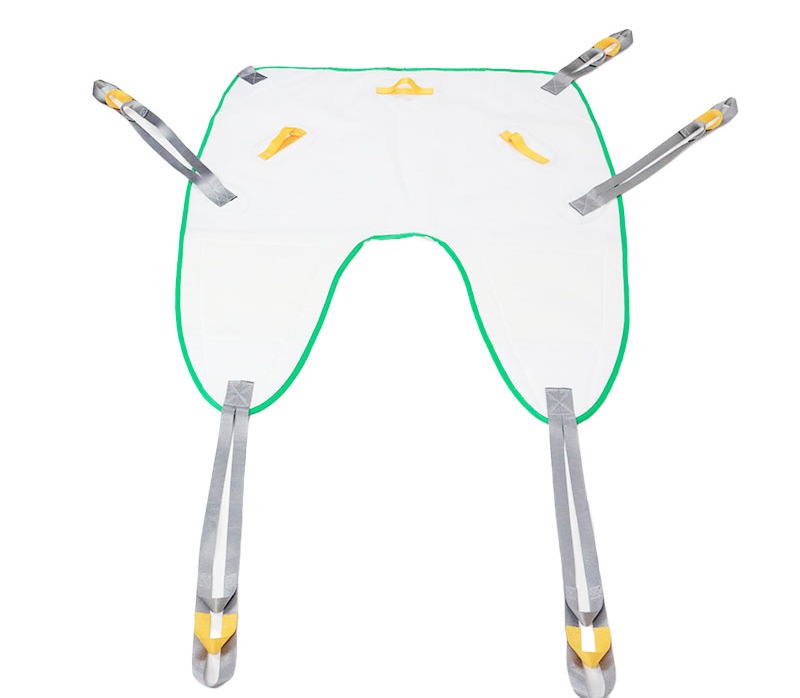Transfer slings, used in conjunction with mechanical patient lifts, are indispensable tools for safely moving individuals with limited mobility. However, the term “transfer sling” encompasses a variety of designs, each tailored to specific patient needs and transfer situations. Choosing the correct type of sling is crucial for ensuring patient comfort, dignity, and above all, safety during the transfer process. This post provides a comprehensive analysis of the most common types of transfer slings, helping you understand their unique features and applications.
1. Why Different Sling Types Are Essential
Patients requiring assistance with transfers have diverse needs. Factors such as their mobility level, medical condition, body shape, and the specific type of transfer required (e.g., bed to chair, chair to toilet) all influence which sling will be safest and most effective. Using the wrong type of sling can lead to discomfort, instability, or even injury. Understanding the different options is key to providing optimal care.
2. Analyzing the Most Common Transfer Sling Types
Here’s a breakdown of the primary types of transfer slings you’ll encounter:
2.1. Universal / General Purpose Sling
- Description: This is perhaps the most widely used type. It typically supports the patient’s back and extends under the thighs. Universal slings often come with or without head support.
- Best For: General lifting and transfers for patients with some degree of trunk control but who require significant assistance. Ideal for bed-to-chair, chair-to-bed, and bed-to-stretcher transfers.
- Key Features: Versatile, relatively easy to apply and remove in seated or lying positions, provides a comfortable supported sitting position.
- Considerations: Head support is crucial for patients with poor head or neck control. Ensure proper leg positioning for comfort and security.
2.2. Toileting Sling
- Description: Designed with an opening at the bottom, allowing for easy access to clothing for toileting or hygiene purposes. It typically provides support to the back and under the arms.
- Best For: Transferring patients to and from a toilet, commode, or for changing incontinence products. Requires the patient to have some trunk and head control.
- Key Features: Open bottom for hygiene access, often features padded areas for comfort under the arms, may have a waist or chest strap for added security.
- Considerations: Must be applied correctly to ensure patient feels secure and to prevent slipping. Requires good communication with the patient.
2.3. Seated / Chair Sling
- Description: Similar in shape to the universal sling but often designed to provide extra support to the trunk and thighs when the patient is in a seated position. Some are designed to be left in place in a wheelchair or chair.
- Best For: Patients who spend significant time in a chair or wheelchair and need comfortable, stable support during transfers. Suitable for chair-to-chair or chair-to-bed transfers.
- Key Features: Provides good trunk and thigh support, designed for comfort while seated, some models are breathable to be left under the patient.
- Considerations: May require careful application to ensure proper seating posture in the sling.
2.4. Lying / Full Body Sling
- Description: A large sling that fully supports the patient from head to foot. It is designed for patients who have very limited or no mobility and require complete support during the transfer.
- Best For: Transferring patients from a lying position (bed to stretcher, bed to bath), lifting from the floor, or for patients who are completely dependent and lack trunk/head control.
- Key Features: Provides comprehensive support to the entire body, often includes integrated head support, distributes patient weight evenly. Mesh versions are available for bathing.
- Considerations: Can be more challenging to apply and remove under a completely immobile patient. Requires careful positioning to ensure patient comfort and airway clearance.
3. Factors to Consider When Choosing a Sling
Selecting the right transfer sling involves assessing several factors:
- Patient’s Mobility and Physical Condition: Can they bear any weight? Do they have trunk or head control? Are there any painful areas or contractures?
- Type of Transfer: Where is the patient being moved from and to (bed, chair, toilet, floor)?
- Patient Comfort and Dignity: Which sling type will be most comfortable and least intrusive for the individual?
- Sling Size and Weight Capacity: Ensure the sling is the correct size for the patient’s body shape and weight, and that its weight capacity is compatible with the lift being used.
- Lift Compatibility: Ensure the sling’s attachment points are compatible with the specific model of patient lift.
- Material: Consider material properties like breathability (if left under the patient), ease of cleaning, and suitability for wet environments (e.g., mesh for bathing).
4. The Importance of Proper Sizing and Application
Even the best type of sling will not be safe or comfortable if it is the wrong size or applied incorrectly. Always follow the manufacturer’s instructions for application and ensure the sling is correctly positioned and securely attached to the lift before initiating any transfer.
5. Conclusion: Matching the Sling to the Individual Need
Transfer slings are vital tools for safe patient handling, but their effectiveness is maximized when the correct type is chosen for the individual patient and the specific transfer task. From the versatile universal sling to specialized toileting and full body slings, each design serves a distinct purpose. By understanding the differences between sling types and carefully assessing patient needs, caregivers can ensure transfers are performed with the highest level of safety, comfort, and dignity, benefiting both the patient and themselves.

